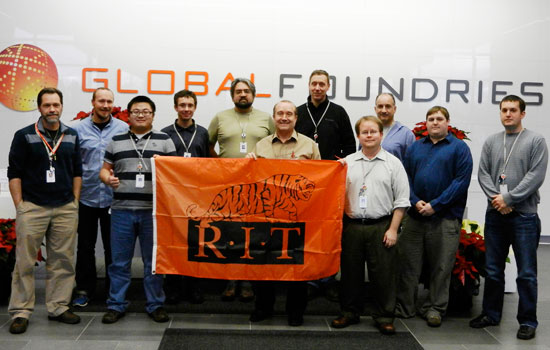A Tiger habitat at GlobalFoundries
Provided by Robert Pearson
GlobalFoundries in Malta, N.Y., employs nearly 35 RIT alumni, including Sheldon Meyers, left; Bob Mulfinger; Xu Chen; Aaron Chadwick; James Constantino; Robert Pearson, microelectronic engineering program director; David Lundeen; Daniel Smith; Ted Caramberis; Justin Blair; and Ryan Sweeney.
Who knew there were so many Tigers in one spot? Nearly 35 RIT Tigers and counting—in the technology habitat of GlobalFoundries in Malta, N.Y.
Robert Pearson, microelectronic engineering program director in RIT’s Kate Gleason College of Engineering, met with the program’s most recent graduates as well as alumni who are now high-level managers and executives with the company while he was in town.
Most were surprised to see peers in all levels of the organization, says David Lundeen ’98, a process engineer who has been with the company for 14 years and works in the wafer fabrication environment.
“It’s a challenging industry, especially with advanced technology nodes that GlobalFoundries is developing,” he says. “But the rewards, when it all finally works, is exciting.”
Sheldon Meyers ’89 agreed. The industry is never boring, he says, and as it is evolving, the need for experienced people is imperative. Meyers, who does lithography research at GlobalFoundries, has advised laboratory assistants in the microelectronic engineering undergraduate program, helping the students connect coursework with the latest demands in high tech fabrication facilities like those found at GlobalFoundries.
Within the semiconductor industry, job growth is expected in the areas of research and development, applications testing and engineering and advanced power management technologies. In the past few years, RIT graduates were among the top hires within corporations such as GlobalFoundries and others that make up a major high technology corridor developing in the Albany area—not surprising with more than 1,000 graduates since the microelectronic engineering program was established in 1982.
“It is the most exciting industry,” Meyers says. “RIT gave me a basic semiconductor education in all areas. The small class sizes allow for real hands-on education, and it was the right mix of theory and lab work.”
Add to that mix co-op experiences, and RIT graduates have been able to step into job functions quickly. “RIT was great, if nothing else for the co-ops,” says Justin Blair ’09. “I kept getting questions about being a new college graduate because my resume had relevant jobs already.”







